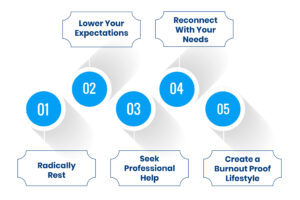Living with ADHD presents a unique set of challenges, from managing attention to controlling impulses. When the constant effort to navigate a world not designed for your brain becomes overwhelming, it can lead to a state of profound exhaustion known as ADHD burnout. This isn’t just feeling tired; it’s a deep-seated physical, mental, and emotional depletion that can significantly impact your life.
This article will guide you through the complexities of ADHD burnout. We will explore what it is, its specific symptoms, and its root causes. You will learn practical strategies for recovery, how to support an ADHD partner burnout experiencing burnout, and ways to prevent it from happening in the first place.
What is ADHD Burnout?
The ADHD burnout is the condition of extreme fatigue due to years of constant stress of having Attention-Deficit/Hyperactivity Disorder. It comes about when the mental and physical resources to cope with the symptoms of ADHD and conceal them in social or workplace conditions are exhausted.
In contrast to the general burnout, which can be related to the working process, the ADHD burnout is due to the lifelong struggle to become a functional person in the neurotypical world. The ongoing internal conflict to concentrate, arrange, and control feelings comes at a cost, and a shutdown occurs, in which it becomes impossible to perform even the simplest of tasks.
ADHD Burnout Symptoms and Signs
The first step to recovery is the identification of symptoms of burnout ADHD. Symptoms may be different, but they tend to be an extreme form of your regular ADHD problems, plus an addition of exhaustion and emotional pain. The following are the major signs of ADHD burnout:
Symptoms of ADHD aggravate, with deterioration of executive dysfunction. It may seem that you can hardly start doing anything (task paralysis), decide, or recall stuff.
- Emotional Dysregulation: You can feel extra sensitive, irritated, moody, or very depressed and hopeless. Even minor inconveniences may create extreme emotional responses.
- Loss of Motivation and Interest: Things you would enjoy doing are no longer enjoyable. An overall feeling of apathy and disinterest replaces this.
- Hypersensitivity To Sensory overload: You may be easily overstimulated by noise, light, or touch. The world is too noisy and too bright.
- Social Withdrawal: It is tiring to socialize, so you avoid your friends, family, and social gatherings.
What Causes ADHD Burnout?
The ADHD burnout does not occur instantly. It is the outcome of stress caused by a number of factors. Knowing these causes can assist you in knowing your own triggers.
1. Masking
It psychologically drains you to attempt to conceal your ADHD symptoms to fit in. People refer to this as masking, which involves imitating typical behavior, suppressing hyperactivity, and forcing concentration in unnatural forms.
2. Rejection Sensitive Dysphoria (RSD)
A significant number of individuals with ADHD generate excessive emotional distress with respect to receiving criticism or rejection. Perfectionism and overworking directly cause burnout and may motivate individuals by the fear of failure or disapproval.
3. Poor Support and Accommodation
Having to live or work in an environment that does not even recognize or support your ADHD needs makes you strain much harder than your non-disabled colleagues to survive.
ADHD Burnout in Women
Women tend to have varied symptoms of ADHD, which result in late or missed diagnosis. The inattentive type of ADHD among women is more common, and they internalize their predicament. People tend to socialize them to be people-pleasers and learn how to conceal their symptoms to impress society. Such a continuing struggle to look put together makes them especially vulnerable to burnout. The burnout is commonly unmerited as anxiety or depression, which postpones proper diagnosis and assistance.
ADHD Burnout Vs Depression vs. Autistic Burnout
1. ADHD Burnout vs Normal Burnout
Symptoms such as fatigue, low mood, and loss of interest have a lot of overlap. But the alteration is the most important in the context. Depression is an enduring mood disorder that may exist on its own. Worn-out coping mechanisms are the direct cause of ADHD burnout. Although you may have both, treatment of the burnout may include rest and demand reduction, which may not be sufficient to treat clinical depression.
2. ADHD Burnout Vs Autistic Burnout
Both are caused by the exhaustion of navigating a neurotypical world. However, the primary drivers differ. Autistic burnout is often triggered by sensory overload and the stress of masking social communication differences. ADHD burnout is more commonly linked to the mental strain of executive dysfunction and emotional dysregulation.
How to Recover from ADHD Burnout?

How to deal with adhd burnout? Let’s find it out here! The process of ADHD burnout recovery takes time and requires self-understanding and tolerance. It can never happen instantly; rather, it is a matter of gradually cutting down and restoring your energy.
1. Radically Rest
The most important and first thing that is considered is resting. This does not only refer to sleeping. It translates to lessening cognitive, social, and emotional burdens.
- Go on leave at your convenience.
- Get someone to do the chores around the house, or leave them to go. The washing will not bring the world to an end.
- Turn down social engagements and unnecessary engagements.
2. Lower Your Expectations
Perfectionism is a significant source of burnout. Learn to allow yourself to be flawed. Strive to achieve good, as opposed to perfect. Reward minor achievements, such as a shower or a meal.
3. Seek Professional Help
How to treat adhd burnout? An ADHD specialist, therapist, or coach can be of immeasurable help. They will be able to assist you in learning coping mechanisms, learning about your triggers, and offer a safe place to de-escalate. ADHD medication may also be an essential component of the puzzle, as doctors may use it to control the main symptoms that cause burnout.
4. Reconnect With Your Needs
Burnout alienates you from yourself. Take time to find out what truly gives you energy. This might be an artistic pastime, walking around in the world, or listening to music. Concentrate on things that do not involve intense executive functioning.
5. Create a Burnout-Proof Lifestyle
- After you begin to feel better, the emphasis is on prevention.
- Recognize and Eliminate Triggers: Was it overworking? Masking? Develop management strategies towards these triggers.
- Use Accommodations: Help your ADHD brain. These are calendars, reminders, noise-altering headphones, and body-doubling.
- Be Self-Compassionate: Be as kind to yourself as you might be to a friend. Accept the fact that you have a different brain, and it is alright.
ADHD Spouse and Partner Burnout
The process of helping an ADHD spouse burnout can be challenging, and the partner without the condition often develops some burnout. This is usually as a result of having to take up a bigger portion of domestic chores, emotional dysregulation, and not feeling like you have to be the family organizer.
Communication is an important aspect in case you are an ADHD partner and are experiencing burnout. Not only talk openly about the division of labor, but also find couples counseling to learn to communicate with each other better, and ensure you are creating time to take care of yourself. One cannot pour when the cup is empty.
Final Thoughts
ADHD burnout may be fatiguing and tedious, but it does not have to be the battle of a lifetime. Conceptualizing its underlying causes and detecting its early signs enable you to make significant progress on the road to recovery. It is about accepting rest, self-knowledge, and finding a balance by working with your brain and not against it.
We provide specialized care based on assisting people with ADHD in coping with the condition via comprehensive primary assessments and individualized medication at MAVA Behavioral Health. Our caring professionals are aimed at emotional balance, better concentration, and alleviating symptoms of burnout.
When you have proper guidance and medical assistance from MAVA Behavioral Health, you will be able to take your life under control, establish healthy habits, and experience mental health in the long term. A person can heal one step at a time with the proper care and knowledge.
FAQs
How to fix adhd burnout?
You cannot mend it in a night, but you can heal. The first step involves radical rest to reduce your mental and emotional burden. Lessen your engagements, delegate, and leave some things undone.
What is the duration of recovery due to ADHD burnout?
The time of recovery takes more or less time, depending on the intensity of the burnout and the situation of the individual. It may take several months to just a couple of weeks. The biggest thing is to give oneself time and take the process at a slow pace.
How does the ADHD burnout cycle take place in adults?
High energy or hyperfocus usually initiates the ADHD burnout cycle when a person overcommits and works herself to exceed high expectations (and does so due to fear of failure). This extreme work results in fatigue.
How to avoid ADHD burnout?
Prevention entails the establishment of a sustainable life. It involves being realistic, employing tools and approaches to help with your executive capabilities, taking time to rest before you absolutely have to, and practicing self-compassion. It is also important to be aware of your personal triggers and know how to say no to avoid future burnout.
Does AD medication aid burnout?
Medication is not a literal cure for burnout, but it may play a crucial role in recovery and prevention. Stimulant or non-stimulant medicines may assist in better attention, less impulsive behavior, and decreased cognitive burden of coping with ADHD symptoms.









